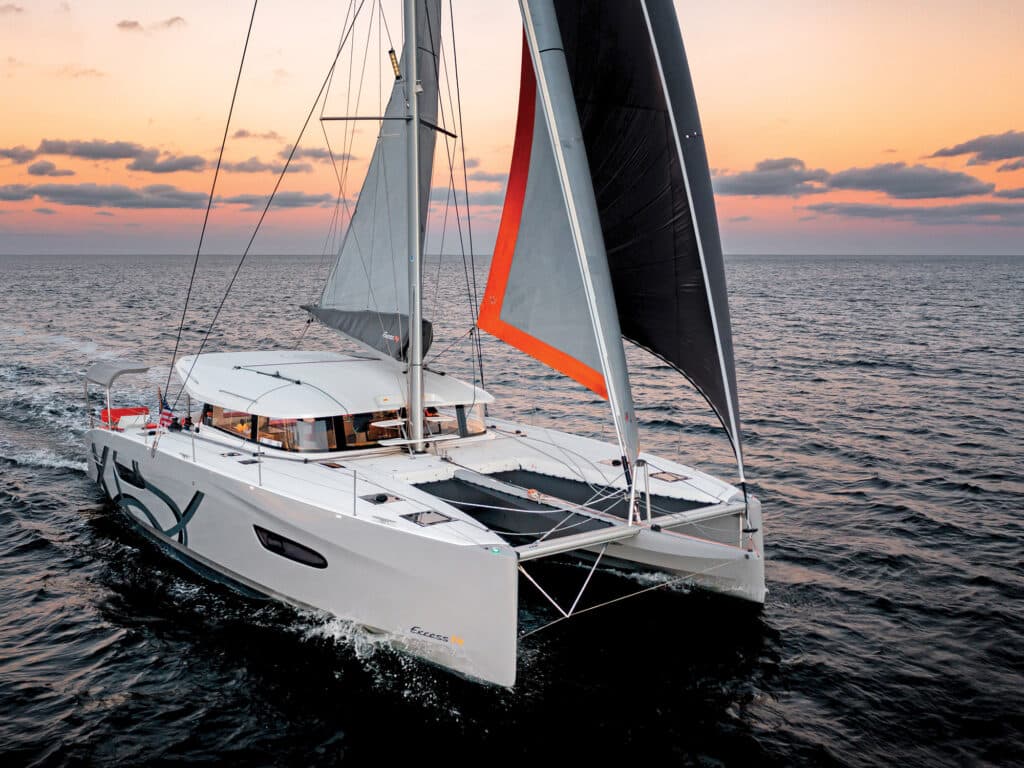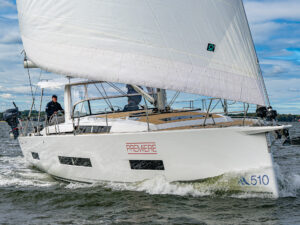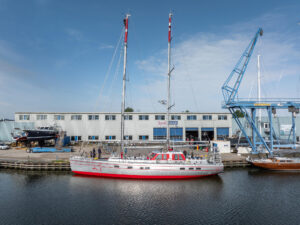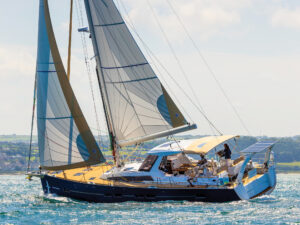
When Groupe Beneteau’s Excess Catamarans introduced its first model in 2019, a test sail in winds approaching 40 knots made it abundantly clear that the 38-foot-7-inch Excess 12 wasn’t just another pretty new face in the ever-growing cat crowd. That boat could sail.
A recent light-air outing aboard the company’s newest model, the Excess 14, was perhaps equally revealing. With a hull length right around 44 feet and a beam of 25 feet, 9 inches, this is a big, roomy and comfortable cruising cat. But in just 5 knots of breeze, sailing with the main and working jib set, the chart plotter’s speed over ground read 4.1 knots heading upwind with the sails sheeted hard. A little later, with the jib rolled up and the code zero unfurled and set on a sprit that brings the boat’s LOA to 52 feet, 5 inches, our boatspeed was 5.7 knots on a reach in wind gusting to maybe 6.
Those were conditions that would have left a lot of similar-size multihulls parked, but the Excess 14 felt relatively lively underway and “tacked quickly,” I wrote in my notes. I also noted that line handling was easy, thanks to sheet winches within reach of the helms and an electric Harken FlatWinder winch that handles a traveler mounted outboard of a comfortable bench seat that spans most of the transom.
For the record, I’m a fan of the Excess brand DNA that calls for outdoor helm stations located far aft on either stern. Sitting at them underway, you can see and hear the water rush by and feel the breeze in your face. You know, like when you’re sailing. You can converse with people seated in the cockpit, and you have easy access to the salon should you care to set the autopilot and keep watch out of the elements, through windows that provide nearly 360 degrees of visibility.
Open to fresh ideas, the team at Excess started with a blank slate when they conceived the 14, and they gave naval architects at VPLP Design some liberty in terms of hull design in their quest for better performance. VPLP, drawing from their experience with a long line of racing machines, then tested and ultimately opted for asymmetrical hulls—think of a monohull sliced lengthwise down the middle and then separated—that tend to reduce the size of the waves produced between the hulls, thereby reducing drag that slows down the boat.
The design team also toyed with replacing the stub keels affixed to most cruising cats, including earlier Excess models, with the sort of lifting daggerboards found on high-performance cats. They dropped that idea, however, because daggerboards add complexity when sailing and take away from living space below. Instead, the 14 has more-efficient, deeper and thinner fixed foils that increase draft to 4 feet, 10 inches—a few inches deeper than what you would expect to find on cats of a similar size.
There are also interesting innovations found in the 14’s interior, where saving weight has a direct relationship to livelier sailing. Relatively lighter carbon-fiber cloth is employed in some structural areas for strength, and some bulkheads are infused using foam coring. And there’s less wood used in furniture, drawers and stowage areas. Overhead, the cabin top is injected-molded, eliminating the need for a liner. And in hulls with two staterooms and two head compartments located amidships, the toilets share a single holding tank to reduce plumbing, while the staterooms share one larger Webasto air-conditioning unit, saving the weight and wiring required for two.
Excess is also involved with Groupe Beneteau’s overall efforts to adopt more-sustainable building practices. Laminates used for the performance mainsail and genoa are recycled material, and hemp fibers are used in place of fiberglass and injected with partly bio-sourced resin in some nonstructural parts such as locker lids. Even furniture knobs have been replaced by neat little loops of rope.
Buyers have a few decisions to make when ordering an Excess 14. There is a four-stateroom version that would be well-suited for charter, and there are a couple of three-stateroom options. In one, the owner gets a large fore-and-aft bunk aft, a sitting area with a desk at the foot of the companionway, a head and shower forward, and a walk-in closet in place of a V-berth. A second plan, called the Transformer Version, has bunks far forward that can be folded down for sleeping or up for stowage. (One company photo shows a paddleboard stashed away there.) That’s the layout we saw in Miami and the one I’d choose if it were my boat. In all the layouts, the salon gets lots of sunlight and has a pleasant, airy feeling with the sliding door and window open aft. There’s an abundance of fridge and freezer space adjacent to the galley to port. Dining tables are indoors, at the front of the salon, and in the cockpit.
The Miami boat included a pair of optional 57 hp Yanmar diesels with saildrives (45 hp engines come standard) that pushed us along at 7.8 knots in cruising speed and 8.4 knots in get-home-quick mode. Gear included an electric winch at the starboard helm to make raising the main easier, as well as engine controls at either wheel to make docking simpler. Davits are available, as are canvas Biminis over the wheels for shade.
The boat also had an optional seating area on the flybridge. It reminded me a bit of a stretch version of the footwell that you’d find on a Sunfish. I’m not sure if it’s an option I’d choose, and with the boom set relatively low on the mast, it wouldn’t be a place to lounge underway. Some might like to sit up there while at anchor to enjoy the view though.
The sail-away price for the boat we visited is right around $980,000, but that’s loaded with gear, including an Onan generator and a Pulse rig and sail package that includes a 70-foot-8-inch mast instead of the standard 64-foot-11-inch spar. The upwind Pulse rig sail area of 1,453 square feet will be appreciated by those who sail in variable conditions and like to go fast; in the trades, the standard 1,323 square feet might suffice, and the shorter rig would let you just squeeze under most Intracoastal Waterway bridges.
Me? I was happy to have the added horsepower provided by the bigger square-top main. Sailing a big cat in 5 knots of breeze isn’t always fun, but aboard the Excess 14, we had a jolly old time.
Excess 14 Specifications
| LOA | 45’9″ (13.94 m) |
| LWL | 45’9″ (13.94 m) |
| BEAM | 25’9″ (7.85 m) |
| DRAFT | 4’10” (1.47 m) |
| SAIL AREA | (100% Std/Pulse) 1,323/1453 sq. ft. (123/135 sq. m) |
| DISPLACEMENT | 28,219 lb. (12,800 kg) |
| DISPLACEMENT/ LENGTH | 150 |
| SAIL AREA/ DISPLACEMENT | (Std/Pulse) 22.8/25.1 |
| WATER | 79 gal. (300 L) |
| FUEL | (x2) 53 gal. (200 L) |
| HOLDING | (x2) 21 gal. (80 L) |
| MAST HEIGHT | (Std/Pulse) 64’11″/70’8″ (19.79/21.54 m) |
| ENGINE | 2x 45 hp Yanmar, saildrive |
| DESIGNER | VPLP Design, Nautor Design |
| PRICE | $980,000 |
| WEBSITE | excess-catamarans.com |
Sea Trial
| WINDSPEED | 4-6 knots |
| SEA STATE | Calm |
| MOTORING | Cruise (2,300 rpm) 7.8 knots; Fast (2,800 rpm) 8.4 knots |








